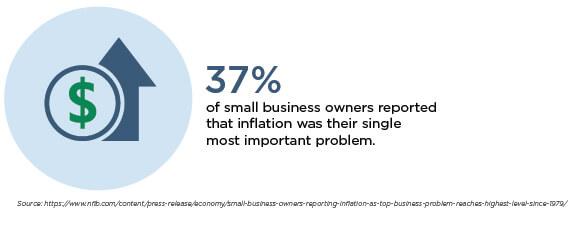Controlling costs is essential to running a profitable business. If you don’t keep track of your operating expenses, it can become nearly impossible to catch issues that reduce your business’s profitability. You may even risk allowing operating costs to spiral out of control and land your books in the red. That’s where cost control comes in.
What Is Cost Control?

The business cost control method is about profitability. Using the cost control process, business owners can identify and manage their business costs with the ultimate purpose of reducing operating expenses. They can then use this information to create a realistic budget and put processes in place to stick to that budget as much as possible.
While this takes time and effort, it allows you to reduce your expenses and gain a deeper understanding of your finances. You’ll ultimately make better informed decisions that improve profitability.
Some small business owners may think that because they have someone handling their accounting, they don’t need to think about how to control cost. But that’s not necessarily true. While accounting is essential to your business, think of it as surface-level financial tracking. Cost control goes beyond balancing books, reconciling accounts and ensuring bills are paid.
Cost control example: Let’s say you analyze costs and realize that inventory storage has been steadily growing more expensive. You can do some research to set a budget for how much you’ll ideally spend on storage. Then, look for ways to get that cost in line with your expectations. Perhaps you shop around for other storage options and find a lower price; maybe you ask suppliers if they can store some of your inventory. Or you could change your purchasing and inventory strategy to be more aligned with demand.
Why Is Cost Control Important?

When you effectively use cost control methods, your business will benefit by:
- Keeping project costs under control. By creating a budget, you gain clarity on project timelines and find opportunities for cutting costs. Say goodbye to rogue spending.
- Reducing operational costs. This helps you ensure that a project’s expenses don’t exceed its revenue. You’re able to generate, maintain and even increase profits.
- Achieving transparency among employees, managers and leaders. Clear cost control guidelines can eliminate confusion, which can also unlock your employees’ productivity and creativity.
In order to reap the benefits of cost control, you’ll want to start tracking cost variance. Ongoing variance analysis shows the difference between what you budgeted and what you actually spent. By monitoring cost variance, you can flag and prioritize areas that need more effort to keep costs under control.

What Are the Different Types of Business Costs?
There are several types of business expenses to monitor as you implement cost control strategies. Consider the following categories in your own business:
- Fixed costs like rent and insurance payments. Because these costs are typically tied to long-term contracts, they’re more difficult to change.
- Variable costs like utility bills, inventory and temporary labor. These costs can fluctuate and can provide more immediate opportunities for cutting costs.
- Direct costs, such as the expense of raw materials. This category is closely tied to production.
- Indirect costs aren’t directly related to your core business. These include your company’s overhead costs.
How to Create and Implement an Effective Cost Control Strategy
Creating, implementing and maintaining an effective cost control strategy requires time and effort. Some business owners choose to outsource cost control. If you’d prefer to handle it in-house, these steps will guide you through the process.
1. Plan Your Resources
Get a clear idea of the resources you need to run your business every day. Then make sure your operating costs include categories for special projects or seasonal pushes. In these situations, scope out each project to estimate the resources you’ll need to succeed. They might include materials, staff time, outsourced talent, marketing and more. Look back at financial data from past projects and ask employees for feedback to help you make accurate predictions.
2. Estimate the Project Cost
Once you have an idea of the labor hours, materials, equipment and specialized skills required to complete a project, estimate the cost for each category in order to land at the total project cost. Then compare this number to revenue expectations to ensure you’ll be profitable.
3. Utilize a Budget
After you green-light a project, take time to create a realistic budget based on your cost predictions. Many effective budgets include timelines to keep costs in check related to labor and rented materials. Of course, unexpected hurdles can arise, so allow some cushion in your budgets. When you build in some budget wiggle room from the start, you have a better chance of maintaining profitability.
4. Monitor the Project and Costs
Make time to monitor expenses throughout the project. Consider scheduling budget check-ins and setting financial benchmarks for key expenses to keep you on track. This will help you see how costs are tracking with expectations. If you’re in danger of going over budget, look into why. Then consider whether there are ways to rein in costs or if you can move budget from other areas to cover overages.
How Cost Control Varies by Business
Cost control measures can vary between industries or by business type, but the general principles remain the same.
Corporate Cost Control

Many corporations regularly evaluate the cost and effectiveness of their business software. For some businesses, software is getting smarter and more effective, with features like built-in artificial intelligence (AI) and machine learning (ML) designed to save time and cut costs.
These days, corporate cost control considerations are also linked to the labor shortage. To combat growing labor costs and drops in productivity, businesses big and small are increasingly turning to robots. Orders for robots rose by 11% in 2022.
To zero in on these and other types of cost cutting opportunities, corporations typically focus on the following areas:
- Creating detailed budgets to monitor actual cost vs. predicted cost.
- Analyzing vendor costs for ongoing business operations.
- Maintaining collaborative relationships with vendors and negotiating annual contracts.
- Putting processes in place like project meetings to track how budgets are pacing.
- Keeping open communication between financial managers and the employees who manage and work on projects.
Cost Control in a Retail Store

While brick-and-mortar stores can use similar cost control measures to corporations, their business also comes with unique challenges. For instance, retail success might depend on foot traffic.
Retail businesses also typically store and display inventory in more public places, making this valuable asset more vulnerable to theft. These challenges require unique cost control measures that even mom-and-pop shops can use, including:
- Analyzing optimal business hours. If certain hours of the day consistently see lower sales, retail stores can reduce store hours to eliminate slow times of day. This can reduce utility bills and labor costs or provide valuable training time.
- Fighting theft and inventory loss. Small business owners might consider investing in a loss prevention team or other security measures to reduce their overall product cost.
- Implementing new technologies that make the sales process more efficient, boost productivity and save on labor costs.
- Creating an online store or joining a digital marketplace to expand their customer base and increase sales.
Cost Control Measures in Manufacturing
Many cost control measures for a manufacturing business center around production processes. When the manufacturing process is more efficient and effective, the business can reduce costs related to time, labor and even defective products. Some ways to control costs in manufacturing include:
- Automating mundane tasks.
- Upgrading equipment when needed.
- Using demand-driven production schedules.
- Reducing waste products.
- Renting robots.
The Importance of Food and Beverage Cost Control
With its tight margins and sometimes seasonal business cycles, cost control measures in the food and beverage industry can make or break a business. A few ways these businesses can better control food and beverage costs include:
- Simplifying menus to focus on best-selling items and offer fewer options overall. This can help prevent food waste and reduce the number of ingredients a restaurant needs to purchase.
- Buying fresh food a few times a week. While bulk ordering may seem efficient and less expensive per item, it doesn’t save money when it results in food spoilage and wasted ingredients.
- Creating menu specials that can help clear out ingredients that will soon spoil.
- Training bartenders to help them pour consistent amounts.
- Optimizing recipes with ingredients that increase profitability.
Cost Control FAQs
What Are the Benefits of Cost Control?
Cost control comes with many benefits. It helps create and maintain profitability; aids in achieving transparency among all stakeholders; generates information that can improve the accuracy of future cost control measures; and offers near real-time insight that can help business owners make course corrections when unexpected costs or issues arise.
How Do You Control Costs in a Business?
Businesses control costs by analyzing their current processes, resources and expenses. From there, they can identify opportunities to reduce costs. Using a budget and setting benchmarks for special projects allows a business to adjust along the way and maintain a project’s profitability.
Next Steps: Want to learn more? Sign up for the Small Biz Ahead newsletter to receive a weekly roundup of the latest tools, trends, and resources.






I enjoyed reading your article. It really explains every detail so well. Thank you.
That’s great to hear. We’re glad you liked the article!
Your article is very valuable for me. Hoping to read more. Thank you.
We’re so glad to hear that, Oliver! Thank you for commenting! We post new articles weekly.
We also have these articles on business expenses:
https://sba.thehartford.com/finance/taxes/business-expenses/
https://sba.thehartford.com/media/podcasts/technology/
I love this newsletter.
We’re so happy to hear that, Johanna! Thanks for leaving a comment!